2005 CHEVROLET SILVERADO lock
[x] Cancel search: lockPage 1 of 580

Seats and Restraint Systems........................... 1-1
Front Seats
............................................... 1-3
Rear Seats
............................................... 1-8
Safety Belts
.............................................1-10
Child Restraints
.......................................1-30
Airbag System
.........................................1-63
Restraint System Check
............................1-79
Features and Controls..................................... 2-1
Keys
........................................................ 2-3
Doors and Locks
....................................... 2-8
Windows
.................................................2-16
Theft-Deterrent Systems
............................2-19
Starting and Operating Your Vehicle
...........2-21
Mirrors
....................................................2-58
OnStar
®System
......................................2-68
HomeLink®Wireless Control System
...........2-70
Storage Areas
.........................................2-75
Sunroof
..................................................2-78
Vehicle Personalization
.............................2-79
Instrument Panel............................................. 3-1
Instrument Panel Overview
.......................... 3-4
Climate Controls
......................................3-20
Warning Lights, Gages, and Indicators
........3-31
Driver Information Center (DIC)
..................3-50
Audio System(s)
.......................................3-69Driving Your Vehicle....................................... 4-1
Your Driving, the Road, and Your Vehicle
..... 4-2
Towing
...................................................4-63
Service and Appearance Care.......................... 5-1
Service
..................................................... 5-4
Fuel
......................................................... 5-5
Checking Things Under the Hood
...............5-12
All-Wheel Drive
........................................5-57
Rear Axle
...............................................5-58
Four-Wheel Drive
.....................................5-59
Front Axle
...............................................5-60
Noise Control System
...............................5-61
Bulb Replacement
....................................5-62
Windshield Wiper Blade Replacement
.........5-72
Tires
......................................................5-73
Appearance Care
...................................5-112
Vehicle Identi�cation
...............................5-122
Electrical System
....................................5-123
Capacities and Speci�cations
...................5-133
Maintenance Schedule..................................... 6-1
Maintenance Schedule
................................ 6-2
Customer Assistance and Information.............. 7-1
Customer Assistance and Information
........... 7-2
Reporting Safety Defects
...........................7-10
Index................................................................ 1
2005 Chevrolet Silverado Owner ManualM
Page 9 of 580
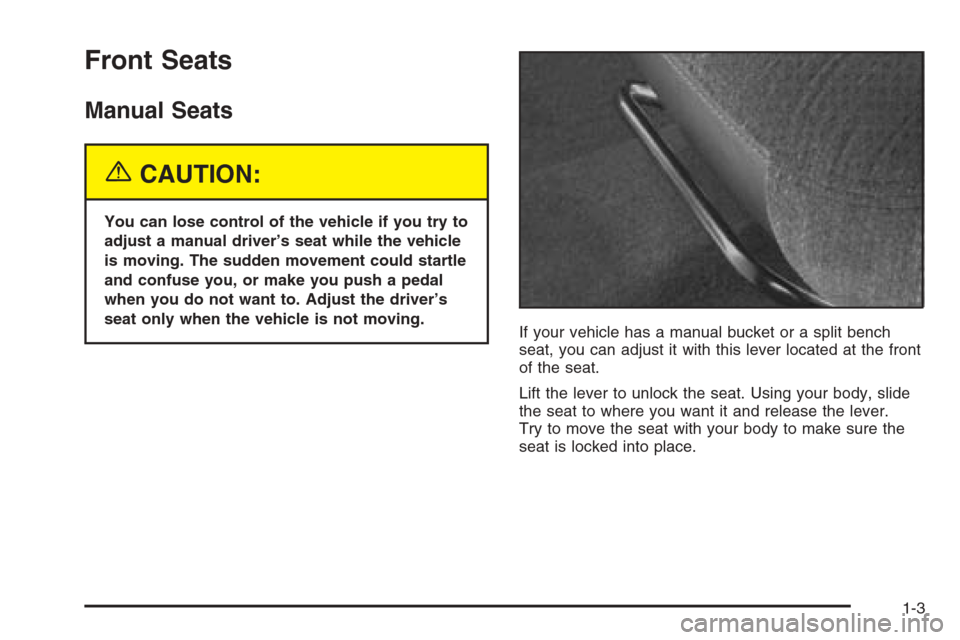
Front Seats
Manual Seats
{CAUTION:
You can lose control of the vehicle if you try to
adjust a manual driver’s seat while the vehicle
is moving. The sudden movement could startle
and confuse you, or make you push a pedal
when you do not want to. Adjust the driver’s
seat only when the vehicle is not moving.
If your vehicle has a manual bucket or a split bench
seat, you can adjust it with this lever located at the front
of the seat.
Lift the lever to unlock the seat. Using your body, slide
the seat to where you want it and release the lever.
Try to move the seat with your body to make sure the
seat is locked into place.
1-3
Page 12 of 580
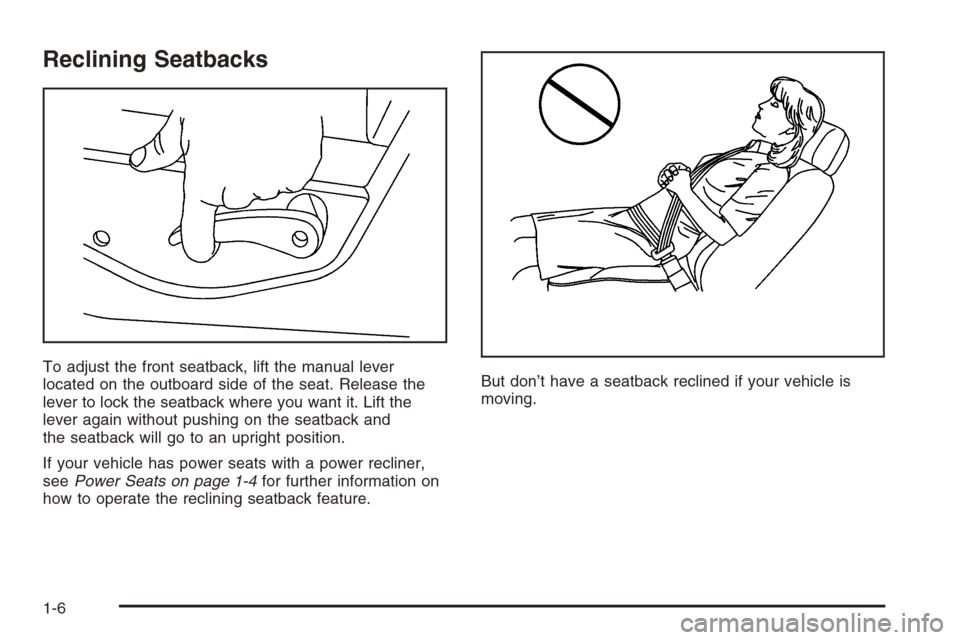
Reclining Seatbacks
To adjust the front seatback, lift the manual lever
located on the outboard side of the seat. Release the
lever to lock the seatback where you want it. Lift the
lever again without pushing on the seatback and
the seatback will go to an upright position.
If your vehicle has power seats with a power recliner,
seePower Seats on page 1-4for further information on
how to operate the reclining seatback feature.But don’t have a seatback reclined if your vehicle is
moving.
1-6
Page 14 of 580
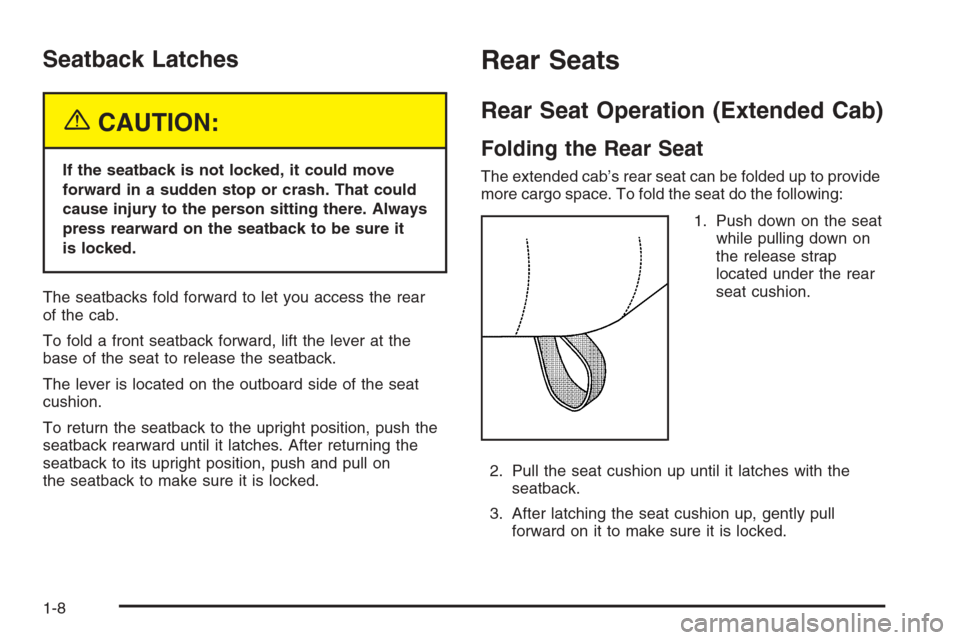
Seatback Latches
{CAUTION:
If the seatback is not locked, it could move
forward in a sudden stop or crash. That could
cause injury to the person sitting there. Always
press rearward on the seatback to be sure it
is locked.
The seatbacks fold forward to let you access the rear
of the cab.
To fold a front seatback forward, lift the lever at the
base of the seat to release the seatback.
The lever is located on the outboard side of the seat
cushion.
To return the seatback to the upright position, push the
seatback rearward until it latches. After returning the
seatback to its upright position, push and pull on
the seatback to make sure it is locked.
Rear Seats
Rear Seat Operation (Extended Cab)
Folding the Rear Seat
The extended cab’s rear seat can be folded up to provide
more cargo space. To fold the seat do the following:
1. Push down on the seat
while pulling down on
the release strap
located under the rear
seat cushion.
2. Pull the seat cushion up until it latches with the
seatback.
3. After latching the seat cushion up, gently pull
forward on it to make sure it is locked.
1-8
Page 15 of 580
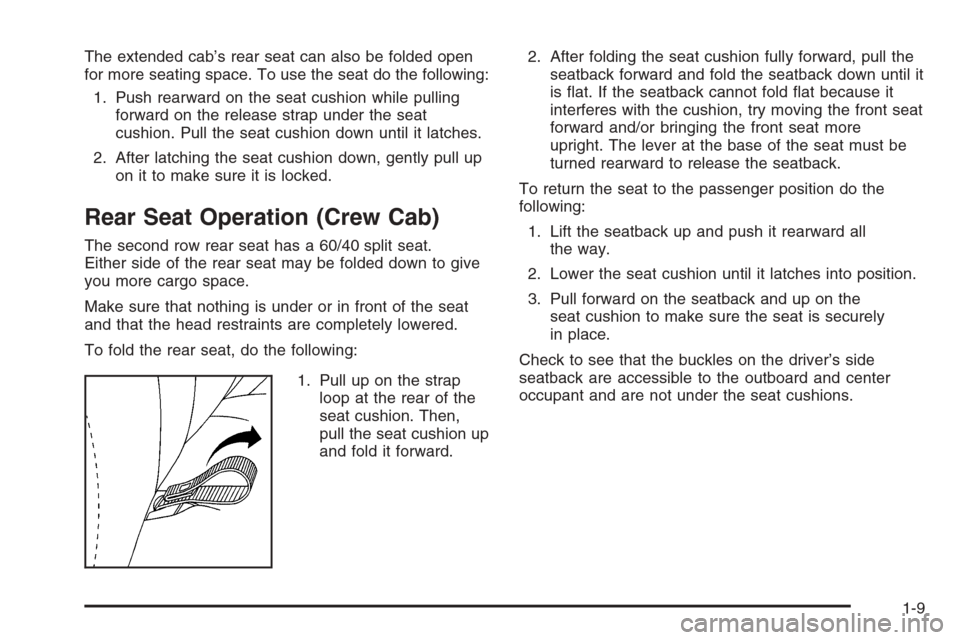
The extended cab’s rear seat can also be folded open
for more seating space. To use the seat do the following:
1. Push rearward on the seat cushion while pulling
forward on the release strap under the seat
cushion. Pull the seat cushion down until it latches.
2. After latching the seat cushion down, gently pull up
on it to make sure it is locked.
Rear Seat Operation (Crew Cab)
The second row rear seat has a 60/40 split seat.
Either side of the rear seat may be folded down to give
you more cargo space.
Make sure that nothing is under or in front of the seat
and that the head restraints are completely lowered.
To fold the rear seat, do the following:
1. Pull up on the strap
loop at the rear of the
seat cushion. Then,
pull the seat cushion up
and fold it forward.2. After folding the seat cushion fully forward, pull the
seatback forward and fold the seatback down until it
is �at. If the seatback cannot fold �at because it
interferes with the cushion, try moving the front seat
forward and/or bringing the front seat more
upright. The lever at the base of the seat must be
turned rearward to release the seatback.
To return the seat to the passenger position do the
following:
1. Lift the seatback up and push it rearward all
the way.
2. Lower the seat cushion until it latches into position.
3. Pull forward on the seatback and up on the
seat cushion to make sure the seat is securely
in place.
Check to see that the buckles on the driver’s side
seatback are accessible to the outboard and center
occupant and are not under the seat cushions.
1-9
Page 21 of 580
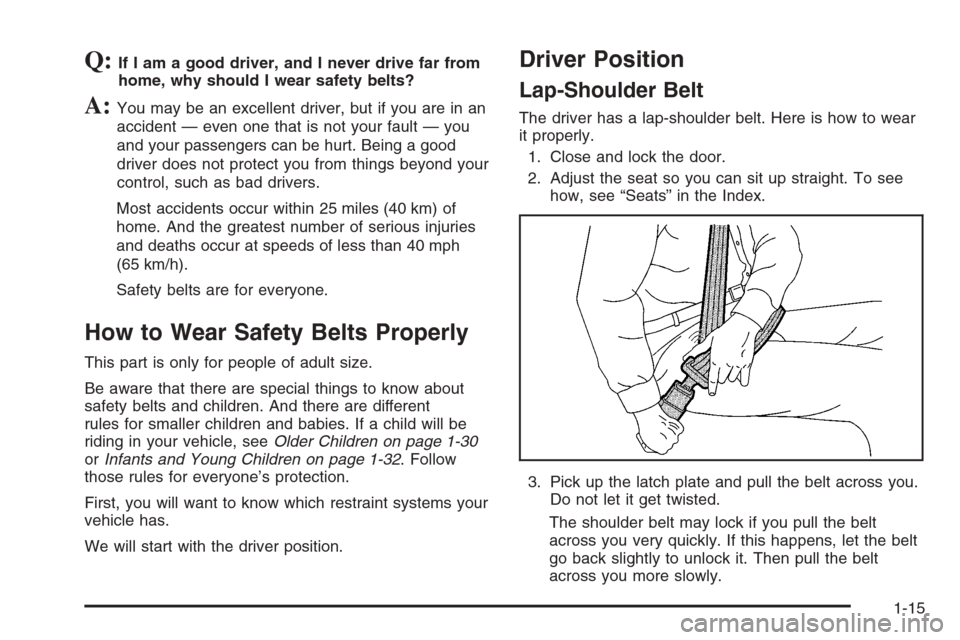
Q:If I am a good driver, and I never drive far from
home, why should I wear safety belts?
A:You may be an excellent driver, but if you are in an
accident — even one that is not your fault — you
and your passengers can be hurt. Being a good
driver does not protect you from things beyond your
control, such as bad drivers.
Most accidents occur within 25 miles (40 km) of
home. And the greatest number of serious injuries
and deaths occur at speeds of less than 40 mph
(65 km/h).
Safety belts are for everyone.
How to Wear Safety Belts Properly
This part is only for people of adult size.
Be aware that there are special things to know about
safety belts and children. And there are different
rules for smaller children and babies. If a child will be
riding in your vehicle, seeOlder Children on page 1-30
orInfants and Young Children on page 1-32. Follow
those rules for everyone’s protection.
First, you will want to know which restraint systems your
vehicle has.
We will start with the driver position.
Driver Position
Lap-Shoulder Belt
The driver has a lap-shoulder belt. Here is how to wear
it properly.
1. Close and lock the door.
2. Adjust the seat so you can sit up straight. To see
how, see “Seats” in the Index.
3. Pick up the latch plate and pull the belt across you.
Do not let it get twisted.
The shoulder belt may lock if you pull the belt
across you very quickly. If this happens, let the belt
go back slightly to unlock it. Then pull the belt
across you more slowly.
1-15
Page 22 of 580
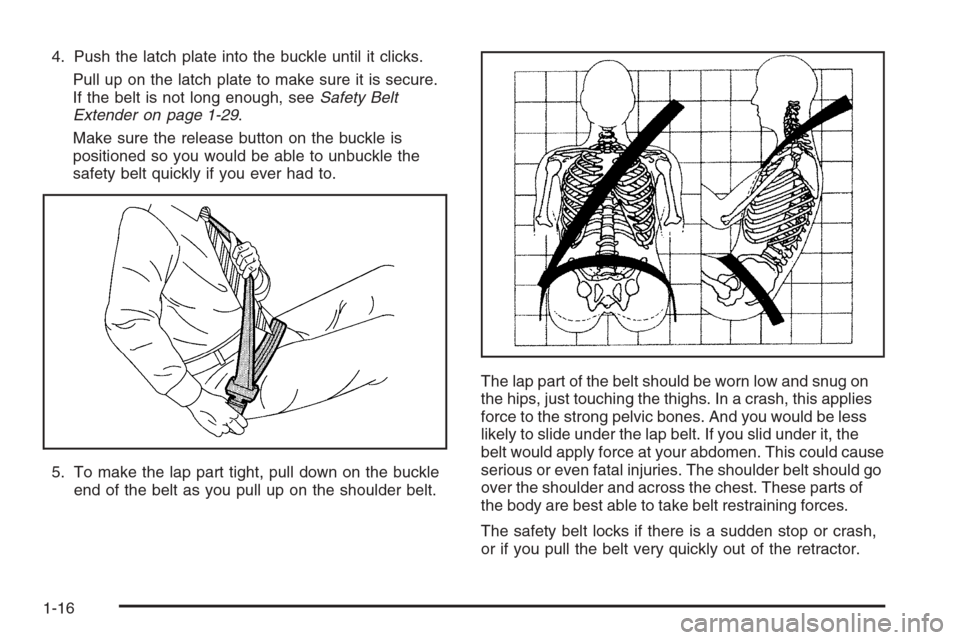
4. Push the latch plate into the buckle until it clicks.
Pull up on the latch plate to make sure it is secure.
If the belt is not long enough, seeSafety Belt
Extender on page 1-29.
Make sure the release button on the buckle is
positioned so you would be able to unbuckle the
safety belt quickly if you ever had to.
5. To make the lap part tight, pull down on the buckle
end of the belt as you pull up on the shoulder belt.The lap part of the belt should be worn low and snug on
the hips, just touching the thighs. In a crash, this applies
force to the strong pelvic bones. And you would be less
likely to slide under the lap belt. If you slid under it, the
belt would apply force at your abdomen. This could cause
serious or even fatal injuries. The shoulder belt should go
over the shoulder and across the chest. These parts of
the body are best able to take belt restraining forces.
The safety belt locks if there is a sudden stop or crash,
or if you pull the belt very quickly out of the retractor.
1-16
Page 29 of 580

Right Front Passenger Position
To learn how to wear the right front passenger’s safety
belt properly, seeDriver Position on page 1-15.
The right front passenger’s safety belt works the same
way as the driver’s safety belt — except for one thing.
If you ever pull the shoulder portion of the belt out all the
way, you will engage the child restraint locking feature
which may turn off the passenger’s frontal airbag.
If this happens unintentionally, just let the belt go back
all the way and start again.
Center Passenger Position
If your vehicle has front and rear bench seats, someone
can sit in the center positions.
When you sit in the center rear seat position of a crew
cab, you have a lap-shoulder belt which is similar to
the rear outside seat positions. To learn how to wear
this belt see “Lap-Shoulder Belt” underRear Seat
Passengers on page 1-24.
Lap Belt
When you sit in a center rear seat position of an
extended cab or in the center front seat position of a
crew cab, an extended cab, or a regular cab, you have
a lap belt.
Your lap safety belt has no retractor. To make the belt
longer, tilt the latch plate and pull it along the belt.
1-23